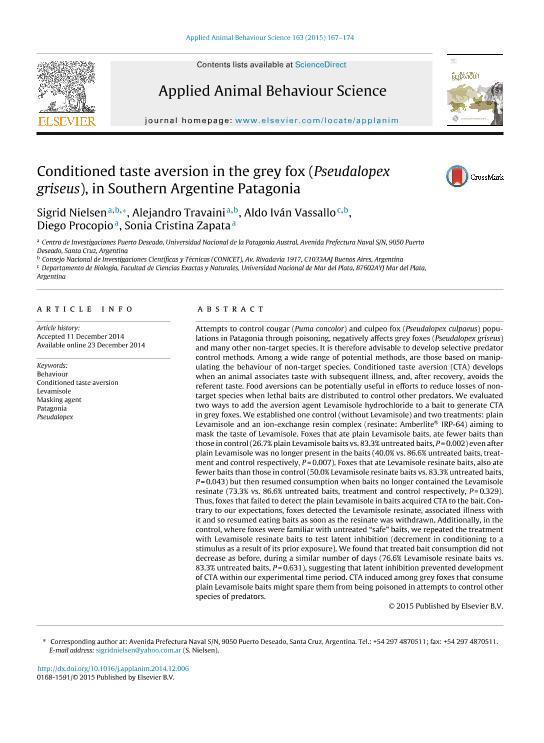Mostrar el registro sencillo del ítem
dc.contributor.author
Nielsen, Sigrid

dc.contributor.author
Travaini, Alejandro

dc.contributor.author
Vassallo, Aldo Iván

dc.contributor.author
Procopio, Diego Esteban

dc.contributor.author
Zapata, Sonia Cristina

dc.date.available
2018-03-05T18:47:41Z
dc.date.issued
2015-02
dc.identifier.citation
Nielsen, Sigrid; Travaini, Alejandro; Vassallo, Aldo Iván; Procopio, Diego Esteban; Zapata, Sonia Cristina; Conditioned taste aversion in the grey fox (Pseudalopex griseus), in Southern Argentine Patagonia; Elsevier Science; Applied Animal Behaviour Science; 163; 2-2015; 167-174
dc.identifier.issn
0168-1591
dc.identifier.uri
http://hdl.handle.net/11336/37814
dc.description.abstract
Attempts to control cougar (Puma concolor) and culpeo fox (Pseudalopex culpaeus) populations in Patagonia through poisoning, negatively affects grey foxes (Pseudalopex griseus) and many other non-target species. It is therefore advisable to develop selective predator control methods. Among a wide range of potential methods, are those based on manipulating the behaviour of non-target species. Conditioned taste aversion (CTA) develops when an animal associates taste with subsequent illness, and, after recovery, avoids the referent taste. Food aversions can be potentially useful in efforts to reduce losses of non-target species when lethal baits are distributed to control other predators. We evaluated two ways to add the aversion agent Levamisole hydrochloride to a bait to generate CTA in grey foxes. We established one control (without Levamisole) and two treatments: plain Levamisole and an ion-exchange resin complex (resinate: Amberlite® IRP-64) aiming to mask the taste of Levamisole. Foxes that ate plain Levamisole baits, ate fewer baits than those in control (26.7% plain Levamisole baits vs. 83.3% untreated baits, P=0.002) even after plain Levamisole was no longer present in the baits (40.0% vs. 86.6% untreated baits, treatment and control respectively, P=0.007). Foxes that ate Levamisole resinate baits, also ate fewer baits than those in control (50.0% Levamisole resinate baits vs. 83.3% untreated baits, P=0.043) but then resumed consumption when baits no longer contained the Levamisole resinate (73.3% vs. 86.6% untreated baits, treatment and control respectively, P=0.329). Thus, foxes that failed to detect the plain Levamisole in baits acquired CTA to the bait. Contrary to our expectations, foxes detected the Levamisole resinate, associated illness with it and so resumed eating baits as soon as the resinate was withdrawn. Additionally, in the control, where foxes were familiar with untreated "safe" baits, we repeated the treatment with Levamisole resinate baits to test latent inhibition (decrement in conditioning to a stimulus as a result of its prior exposure). We found that treated bait consumption did not decrease as before, during a similar number of days (76.6% Levamisole resinate baits vs. 83.3% untreated baits, P=0.631), suggesting that latent inhibition prevented development of CTA within our experimental time period. CTA induced among grey foxes that consume plain Levamisole baits might spare them from being poisoned in attempts to control other species of predators.
dc.format
application/pdf
dc.language.iso
eng
dc.publisher
Elsevier Science

dc.rights
info:eu-repo/semantics/openAccess
dc.rights.uri
https://creativecommons.org/licenses/by-nc-sa/2.5/ar/
dc.subject
Behaviour
dc.subject
Conditioned Taste Aversion
dc.subject
Levamisole
dc.subject
Masking Agent
dc.subject
Patagonia
dc.subject
Pseudalopex
dc.subject.classification
Otras Ciencias Biológicas

dc.subject.classification
Ciencias Biológicas

dc.subject.classification
CIENCIAS NATURALES Y EXACTAS

dc.title
Conditioned taste aversion in the grey fox (Pseudalopex griseus), in Southern Argentine Patagonia
dc.type
info:eu-repo/semantics/article
dc.type
info:ar-repo/semantics/artículo
dc.type
info:eu-repo/semantics/publishedVersion
dc.date.updated
2018-03-02T14:01:43Z
dc.journal.volume
163
dc.journal.pagination
167-174
dc.journal.pais
Países Bajos

dc.journal.ciudad
Amsterdam
dc.description.fil
Fil: Nielsen, Sigrid. Universidad Nacional de la Patagonia Austral. Unidad Académica Caleta Olivia. Centro de Investigaciones Puerto Deseado; Argentina. Consejo Nacional de Investigaciones Científicas y Técnicas; Argentina
dc.description.fil
Fil: Travaini, Alejandro. Consejo Nacional de Investigaciones Científicas y Técnicas; Argentina. Universidad Nacional de la Patagonia Austral. Unidad Académica Caleta Olivia. Centro de Investigaciones Puerto Deseado; Argentina
dc.description.fil
Fil: Vassallo, Aldo Iván. Consejo Nacional de Investigaciones Científicas y Técnicas; Argentina. Universidad Nacional de Mar del Plata. Facultad de Ciencias Exactas y Naturales; Argentina
dc.description.fil
Fil: Procopio, Diego Esteban. Consejo Nacional de Investigaciones Científicas y Técnicas; Argentina. Universidad Nacional de la Patagonia Austral. Unidad Académica Caleta Olivia. Centro de Investigaciones Puerto Deseado; Argentina
dc.description.fil
Fil: Zapata, Sonia Cristina. Universidad Nacional de la Patagonia Austral. Unidad Académica Caleta Olivia. Centro de Investigaciones Puerto Deseado; Argentina
dc.journal.title
Applied Animal Behaviour Science

dc.relation.alternativeid
info:eu-repo/semantics/altIdentifier/url/https://www.sciencedirect.com/science/article/pii/S0168159114003256
dc.relation.alternativeid
info:eu-repo/semantics/altIdentifier/doi/http://dx.doi.org/10.1016/j.applanim.2014.12.006
Archivos asociados
